Expressive painting offers a powerful path to inner peace through mindful creativity and emotional release. You'll need basic supplies like student-grade acrylics, synthetic brushes, and canvas paper to begin your journey. Set up a peaceful workspace with good lighting and ventilation to nurture your creative spirit. As you paint, sync your breathing with deliberate brushstrokes while letting colors guide your emotional expression – cool blues and greens for calm, warm reds and oranges for passion. Start with simple circular motions, working from the center outward, and allow the natural flow of paint to reveal your authentic artistic voice. The deeper you explore these techniques, the more profound your journey to inner peace becomes.
Understanding Expressive Painting Benefits

Artists discover profound emotional release and creative growth through expressive painting. When you engage in this intuitive art form, you'll tap into deeper layers of self-awareness while releasing stress and anxiety through colorful self-expression. You're not just creating art; you're developing a powerful tool for emotional processing and personal development.
Through expressive painting, you'll strengthen your ability to process complex emotions and transform them into visual representations. You don't need formal training to benefit from this therapeutic practice – it's about authentic expression rather than technical perfection. The process helps you develop mindfulness, as you'll focus entirely on the present moment while creating.
You'll also experience improved problem-solving skills as you experiment with different techniques and materials. The freedom to make mistakes without judgment builds confidence and resilience, while the physical act of painting releases endorphins that boost your mood.
Regular practice enhances your creativity in other areas of life, as you'll learn to approach challenges with fresh perspectives and innovative solutions. The skills you gain through expressive painting extend far beyond the canvas, enriching your daily experiences and emotional well-being.
Essential Art Supplies
Starting with basic supplies like student-grade acrylics, synthetic brushes, and canvas paper will let you explore expressive painting without a huge investment.
As you develop your skills, you'll want to upgrade to professional-quality paints, natural hair brushes, and stretched canvas for better color intensity and brush control.
While premium supplies require a larger budget, they'll greatly enhance your artistic capabilities through superior pigments, improved brush responsiveness, and more durable surfaces.
Basic Supplies To Begin
Before diving into expressive painting, you'll need a core set of essential supplies that form the foundation of your artistic toolkit.
Start with quality acrylic paints in primary colors (red, blue, and yellow), as they'll allow you to mix virtually any color you desire. Add white and black to create various tints and shades.
Choose synthetic brushes in different sizes, from broad flat brushes for backgrounds to fine-tipped ones for details. Your canvas selection matters greatly.
Begin with medium-sized canvases or canvas boards, as they're more manageable and cost-effective while you're developing your techniques. Don't forget a sturdy palette for mixing colors and a water container for cleaning brushes.
- Basic Paint Set:
- 3 primary colors (red, blue, yellow)
- White and black
- A plastic or wooden palette
- Brush Collection:
- 1-inch flat brush
- Medium round brush
- Fine detail brush
- Surface Materials:
- 2-3 canvas boards (11×14 inches)
- Palette paper
- Paper towels for cleanup
Premium Tools Worth Investing
Once you've mastered the basics with starter supplies, upgrading to premium tools can dramatically enhance your expressive painting capabilities.
Professional-grade brushes with natural bristles offer superior paint retention and smoother strokes, while high-end synthetic brushes provide excellent spring and durability for specific techniques.
Consider investing in artist-quality paints with higher pigment concentrations. These paints deliver richer colors, better coverage, and improved lightfastness compared to student-grade options.
Brands like Golden, Winsor & Newton, and Daniel Smith consistently produce reliable results.
Your painting surface greatly impacts your work's longevity. Premium cotton canvas, Belgian linen, or archival-quality paper will protect your art from deterioration.
Look for surfaces primed with quality gesso for maximum paint adhesion.
Don't overlook specialized tools like palette knives made from flexible steel, ergonomic brush handles for extended painting sessions, and professional easels with sturdy construction.
A quality stay-wet palette helps maintain paint consistency, while high-end varnishes protect your finished pieces.
Remember to gradually build your collection of premium tools, prioritizing items that align with your preferred techniques and artistic goals.
Creating Your Peaceful Workspace
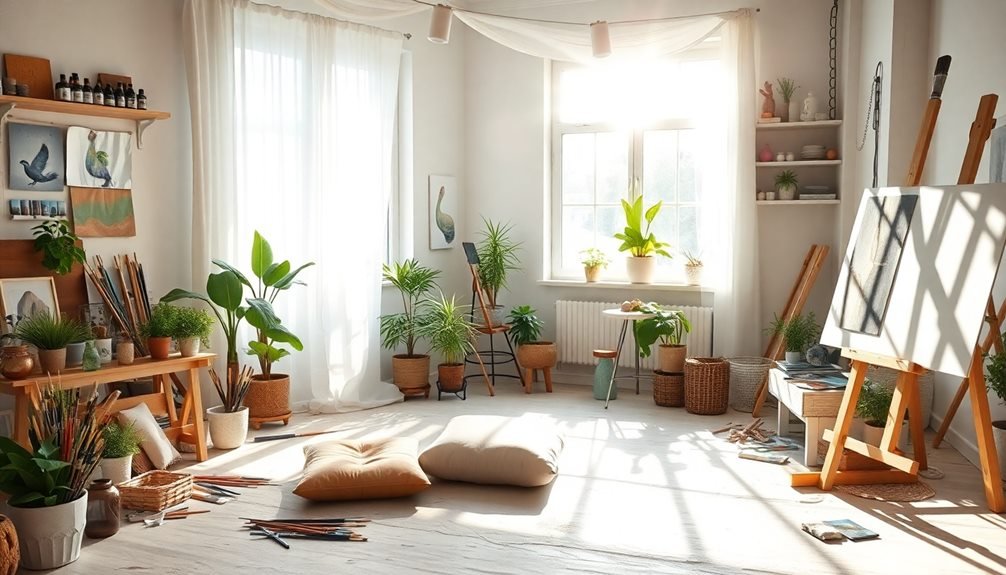
To release your artistic potential, a well-organized and calming workspace sets the foundation for expressive painting. You'll want to create an environment that nurtures creativity while keeping your tools accessible and protected.
Choose a space with good ventilation and natural light, preferably near a window, to maintain proper color perception and protect your health while working with paint materials.
Organization is vital for maintaining a peaceful mindset during your creative process. Set up your workspace with these essential elements:
- A sturdy easel positioned at a comfortable angle, with enough surrounding space to step back and view your work from different distances.
- A mobile cart or table for your paints, brushes, and palette, arranged by color families and size for quick access during painting sessions.
- A dedicated cleaning station with proper waste disposal, brush-washing supplies, and paper towels within arm's reach.
Don't forget to personalize your space with inspiring elements like reference images, meaningful artwork, or plants.
Keep the area clutter-free by implementing a cleanup routine after each session, ensuring you'll return to an inviting space that sparks creativity.
Color Psychology for Emotional Release
Building on your organized workspace, the psychology of color becomes your gateway to emotional expression in painting. When you're feeling overwhelmed, start with cool blues and greens to create a sense of calm and balance. These colors naturally lower blood pressure and reduce anxiety as you apply them to your canvas.
For energetic expression, reach for warm reds and oranges. They'll help you channel passion, anger, or excitement into powerful brushstrokes. Yellow brings optimism and mental clarity, making it perfect for working through confusion or depression.
Purple connects with your spiritual side, while pink softens emotional pain and promotes self-compassion.
Don't hesitate to mix colors that reflect your complex emotions. Black can represent both power and grief, while white symbolizes new beginnings and clarity. When you're processing multiple feelings, layer these colors to create depth in your work.
As you paint, notice how each color affects your mood and energy. Let your intuition guide your color choices – there's no wrong way to express yourself. The colors you're naturally drawn to often reveal underlying emotions you're ready to process and release.
Mindful Brushstroke Techniques
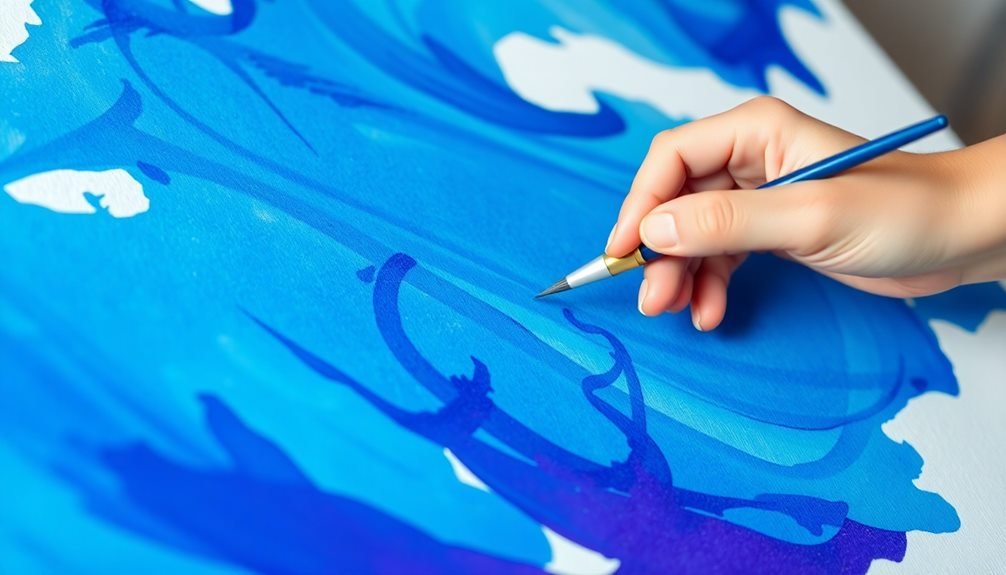
Begin your mindful painting practice by making slow, deliberate circular motions with your brush, allowing each rotation to ground you in the present moment.
You'll find a natural rhythm as you sync your breathing with each brushstroke, inhaling as you lift the brush and exhaling as you make contact with the canvas.
Let the paint flow freely from your brush, releasing your thoughts and emotions through the natural movement of color across the surface.
Slow Circular Brush Movements
Mastering slow circular brush movements requires three essential elements: steady hand control, consistent pressure, and mindful attention to your paint flow. As you create these meditative circles, you'll notice how your brush dances across the canvas, leaving behind graceful, flowing marks that build upon each other like ripples in a pond.
When practicing circular movements, you'll want to:
- Start from your center and work outward, maintaining a relaxed grip on your brush while letting your whole arm guide the motion, not just your wrist.
- Keep your brush at a consistent 45-degree angle to the canvas, adjusting the pressure to create varied line weights and textures.
- Rotate your canvas periodically to maintain comfortable arm positioning and guarantee even paint distribution.
You'll find that these slow, deliberate movements help you develop a deeper connection with your materials while creating mesmerizing patterns.
Focus on maintaining a steady rhythm as you work, and don't rush the process. The circular motions will become more natural with practice, allowing you to express yourself more freely and confidently.
Breathing With Each Stroke
Throughout centuries of artistic practice, synchronizing your breath with your brushstrokes has emerged as a powerful technique for achieving both mental clarity and painterly precision. As you hold your brush, inhale deeply and feel the connection between your body, mind, and the painting surface before you.
When you're ready to make your mark, exhale slowly while guiding your brush across the canvas. Start by matching shorter brushstrokes with gentle breaths, then gradually extend both as you become more comfortable with the rhythm. You'll notice that breathing in before each stroke helps you plan your movement, while breathing out during the stroke allows for more fluid, controlled execution.
This technique works particularly well with water-based mediums like watercolor or acrylic, as their flow naturally complements your breathing pattern. When you're working on detailed areas, take shorter, more focused breaths. For broader, sweeping strokes, deepen your breath to match the movement's scale.
If you find yourself tensing up, pause and take several deep breaths to reset your rhythm. This mindful approach won't just improve your painting technique—it'll help you maintain focus and reduce physical tension throughout your creative session.
Release Through Paint Flow
In accordance with mindful painting principles, releasing control of paint flow creates dynamic, expressive marks that capture raw emotion. As you explore this technique, allow the paint to move naturally across your canvas, embracing its unpredictable nature. Let go of perfectionism and trust that each drip, splash, and pour carries your emotional energy.
Working with paint flow means surrendering to the medium's inherent properties while maintaining a mindful connection to your artistic intention. You'll notice how different consistencies of paint create varied effects: thick paint moves slowly and deliberately, while thinned paint dances freely across the surface.
- Tilt your canvas at various angles, letting gravity guide the paint's direction while focusing on your breathing.
- Experiment with different paint viscosities – add water or medium to create unique flowing patterns that match your emotional state.
- Layer wet-on-wet applications, allowing colors to blend organically without forcing their interaction.
Abstract Emotion Expression Methods
Countless artists harness abstract techniques to convey raw emotions in their work. You'll find that abstract expression allows you to break free from representational constraints and focus purely on emotional energy.
Start by selecting colors that reflect your current emotional state – reds for anger, blues for melancholy, or yellows for joy. Then, let your feelings guide your movements across the canvas.
Try gestural painting by making bold, sweeping strokes that mirror your emotional intensity. You can scrape, splatter, or drip paint to create textural elements that represent different emotional layers.
Don't hesitate to use unconventional tools like palette knives, sponges, or even your hands to achieve varied effects that match your inner state.
Layer your emotions by building up paint in areas of intensity and scratching through to reveal underlying colors where feelings intersect. You might find that certain shapes emerge naturally – sharp angles for frustration, flowing curves for peace.
Nature-Inspired Calming Patterns
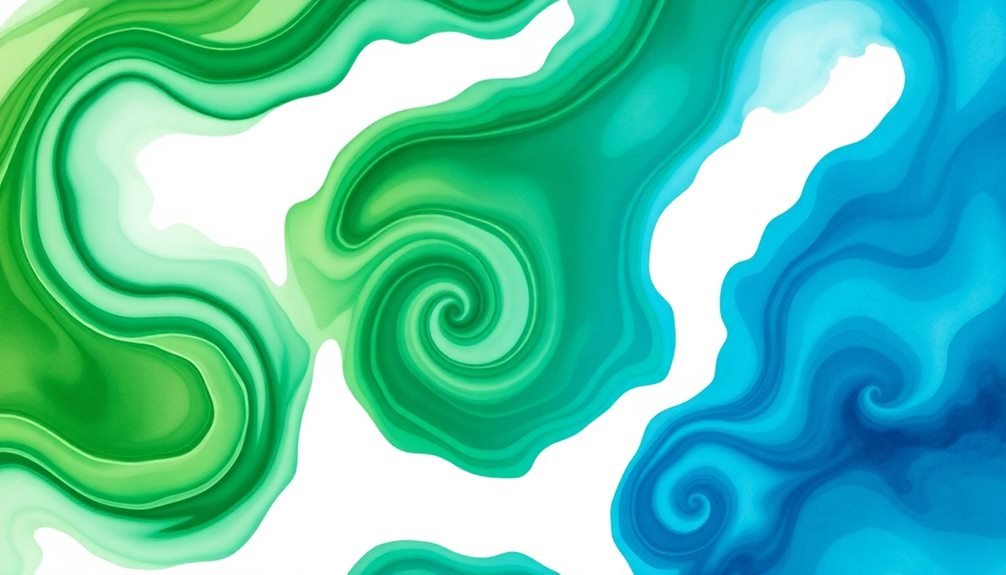
Natural patterns draw out a profound sense of tranquility in artwork, tapping into our innate connection with the organic world.
You'll find that incorporating these patterns into your expressive painting creates a meditative flow that both calms your mind and soothes viewers. By observing nature's rhythms, you can translate these peaceful elements onto your canvas using flowing brushstrokes and harmonious color combinations.
Focus on these nature-inspired patterns to achieve a calming effect:
- Spiral formations inspired by shells and unfurling ferns – create these using continuous, fluid motions while gradually decreasing or increasing the curve's radius.
- Wave patterns derived from water ripples and wind-blown grass – develop gentle, undulating lines using long, sweeping brushstrokes in varying opacities.
- Branch-like structures found in trees and leaf veins – build these through deliberate brush pressure variation and gradual line thickness changes.
Let your brush follow nature's lead as you layer these patterns.
Work with earth tones and cool colors to enhance the calming effect, and don't hesitate to blend patterns together. This organic approach allows your painting to evolve naturally, much like the growth patterns you're emulating.
Breathing Through Paint
Building on the rhythmic patterns found in nature, breathing through paint introduces a powerful mind-body connection to your artistic practice. As you synchronize your breath with your brushstrokes, you'll discover a meditative flow that transforms your canvas into a reflection of your inner rhythm.
| Breath Phase | Painting Action |
|---|---|
| Inhale | Load brush with paint |
| Hold | Center yourself and focus |
| Exhale | Create flowing stroke |
| Rest | Observe your mark |
| Repeat | Build layers mindfully |
Start with a comfortable seated position and take three deep breaths before picking up your brush. You'll want to match your paint application to your natural breathing pattern – inhaling as you load your brush, holding briefly as you prepare, and exhaling as you make your mark. Let each brushstroke flow with your breath's natural cadence.
Don't rush the process. Each breath cycle creates an opportunity for intentional mark-making. You'll notice that slower, deeper breaths lead to longer, more fluid strokes, while shorter breaths produce more dynamic, staccato marks. This technique helps you develop a deeper connection between your emotional state and your artistic expression.
Daily Painting Rituals
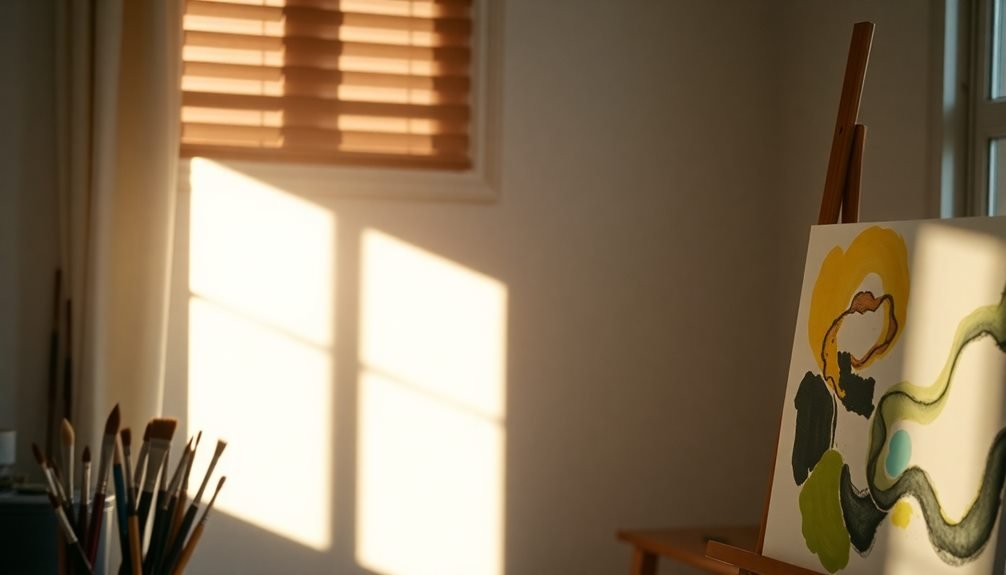
Every successful artist knows that consistent practice transforms creative potential into masterful expression. By establishing daily painting rituals, you'll create a sacred space where creativity flows naturally and technical skills develop organically.
Setting aside dedicated time each day, even if it's just 30 minutes, helps build momentum and maintain artistic growth. Your daily painting ritual should be uniquely yours, reflecting your schedule, energy patterns, and creative goals.
Find a quiet corner in your home, arrange your supplies thoughtfully, and consider incorporating mindfulness practices like deep breathing or gentle stretching before you begin.
- Start each session with a 5-minute warm-up exercise: quick sketches, color mixing, or loose brushwork to loosen your hand and mind
- Keep a painting journal nearby to document techniques, color combinations, and emotional responses to your work
- End your practice by cleaning your workspace and setting an intention for tomorrow's session
Finding Your Artistic Voice
You'll discover your unique artistic voice by allowing yourself to paint intuitively and letting your creative flow guide each brushstroke.
When you embrace your natural tendencies with color and form, you're building a visual language that's authentically yours.
Your personal color symbolism will emerge as you connect specific hues to emotions and experiences, creating a signature palette that speaks to your artistic perspective.
Embrace Your Creative Flow
The journey to discovering your artistic voice begins with releasing expectations and allowing intuition to guide your brush strokes. When you're in a creative flow state, you'll notice time seems to disappear, and your movements become more natural and uninhibited.
This mental space is where your most authentic work emerges, free from self-judgment and external pressures. To maintain this creative momentum, focus on the present moment and let your emotions guide your color choices and brush techniques.
Don't worry about making mistakes – they're often the gateway to unique artistic discoveries. Your flow state thrives when you're fully immersed in the process rather than fixated on the final result.
- Set up your painting space with everything within arm's reach, eliminating distractions that could break your concentration.
- Start with loose, gestural marks to warm up and free your mind from rigid thinking patterns.
- Play instrumental music that matches your desired painting mood to enhance your emotional connection with the artwork.
Explore Personal Color Symbolism
Building on your creative flow, personal color symbolism reveals deeper layers of artistic expression. When you assign meaning to specific colors based on your experiences and emotions, you create a unique visual language that authentically represents your inner world.
Start by creating a personal color journal. List colors that resonate with specific memories, feelings, or life events. Maybe deep purple reminds you of childhood adventures, while mint green connects to moments of healing. Document these associations and explore why they matter to you.
As you paint, let your personal color meanings guide your palette choices. Don't feel bound by traditional color symbolism – your cerulean blue might represent anger instead of calmness, and that's perfectly valid. Experiment with combining colors that share emotional connections in your personal framework.
Consider how color intensity and placement reflect your emotional state. Bold, dominant colors might express strong feelings, while subtle washes could represent quieter moments.
Layer your meaningful colors strategically, allowing them to interact in ways that tell your story. This personalized approach to color will make your artwork distinctly yours while deepening your connection to the creative process.
Building Creative Confidence
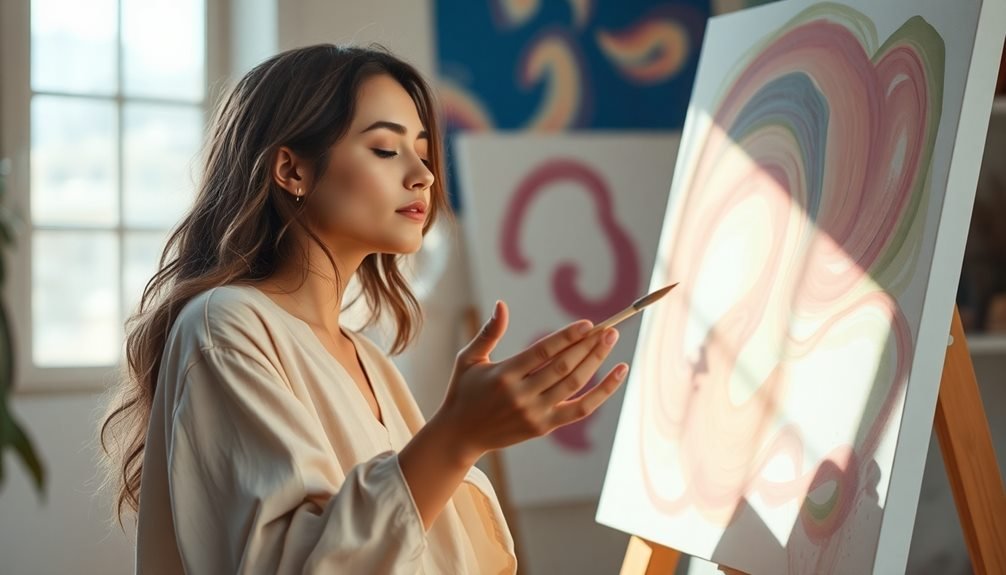
Developing creative confidence starts with understanding that all artists face self-doubt. Even renowned painters have questioned their abilities, but they've pushed through by embracing imperfection and focusing on self-expression rather than perfection.
When you're painting expressively, remember that there's no "wrong" way to convey your emotions through art. Your creative confidence will grow stronger as you practice regularly and celebrate small victories.
Don't compare your work to others; instead, track your own progress and acknowledge how far you've come. Try keeping a visual journal of your artistic journey, noting techniques that work well for you.
To build your creative confidence effectively:
- Start each painting session with a five-minute warm-up exercise, using bold strokes and colors without judgment.
- Set achievable goals for each painting session, like mastering one new technique or exploring a specific emotion.
- Share your work with supportive fellow artists who understand the creative process and can offer constructive feedback.
Frequently Asked Questions
How Long Should Each Expressive Painting Session Last for Optimal Stress Relief?
You'll get the best stress relief from 30-60 minute painting sessions, but listen to your body. If you're feeling relaxed after 15 minutes or need 90 minutes, that's perfectly fine too.
Can Expressive Painting Be Done Effectively in Group Therapy Sessions?
Yes, you'll find group expressive painting highly effective in therapy. You can share emotions, connect with others, and benefit from collective healing. It creates a safe space for mutual support and understanding.
Is Previous Art Experience Necessary to Benefit From Expressive Painting?
You don't need prior art experience to benefit from expressive painting. It's about emotional release and self-discovery, not technical skill. You'll naturally develop your own style as you explore and express yourself.
What Should I Do With Completed Paintings That Trigger Negative Emotions?
You can destroy artwork that triggers negative emotions, transform it into something new, or store it away. If you're ready, use these pieces to explore and process those difficult feelings through art therapy.
How Can I Prevent Creative Burnout While Maintaining a Regular Painting Practice?
You'll avoid burnout by setting realistic goals, taking breaks between sessions, switching up techniques, and listening to your creative energy. Don't force inspiration – let it flow naturally while maintaining a flexible schedule.
In Summary
You've now got the tools to transform your inner chaos into colorful serenity through expressive painting. Don't worry about perfection – your artistic journey is uniquely yours. As you continue practicing these techniques, you'll notice how painting becomes your natural outlet for stress relief and emotional processing. Remember, every brushstroke brings you closer to inner peace and creative freedom. Keep painting, keep breathing, keep growing.

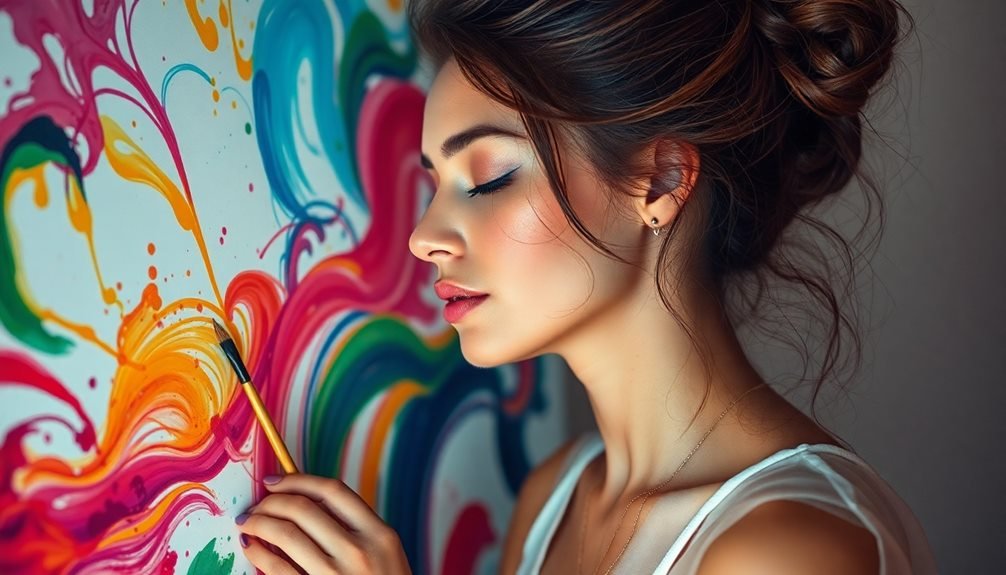
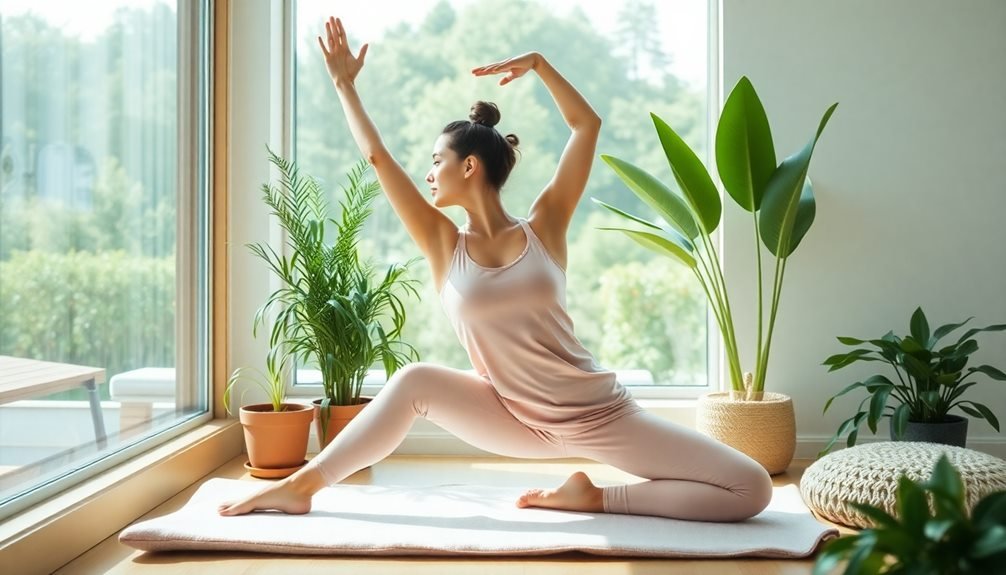
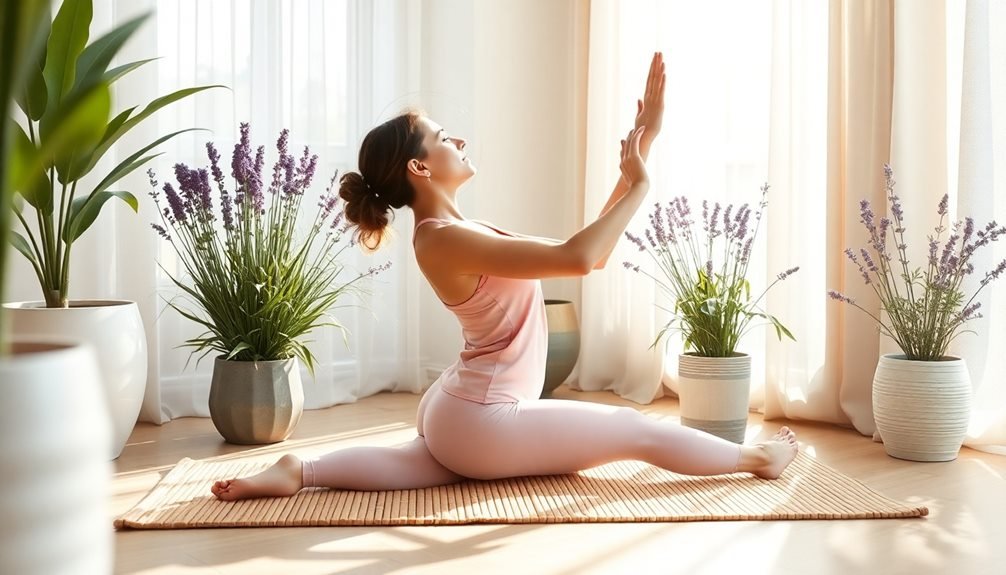
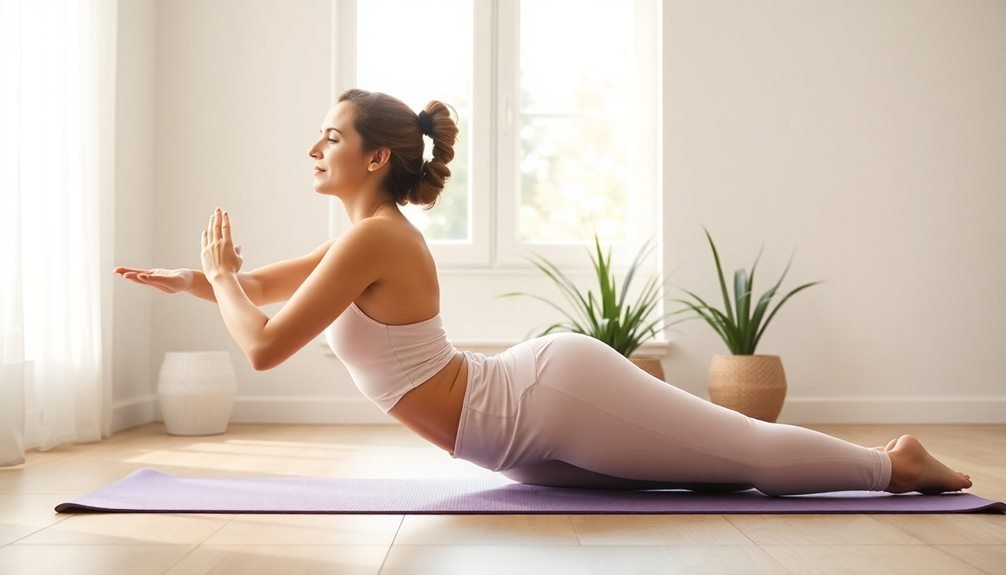
Leave a Reply